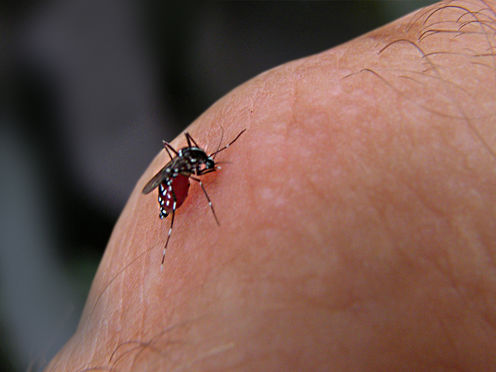
A number of athletes have pulled out of the Rio 2016 Olympics due to concerns about the Zika virus and the widening list of birth defects associated with infections during pregnancy. But Brazilian authorities have said there’ll be “close to zero” cases of Zika recorded during the Olympic Games.
Last year’s dengue outbreak in Brazil certainly supports the idea that mosquito-borne infections dwindle in the cooler winter months, but they hardly “returned to zero”. Dengue reached 35,000 probable cases in the state of Rio by the end of May 2015, then dropped to 1,600 new cases per fortnight throughout August.
Zika had already reached 46,000 probable cases by the end of May 2016 and is transmitted by the same Aedes aegypti mosquito as dengue. Should we then expect to have at least 1,600 cases in Rio during the Olympic Games?
Good and bad news
This is hard to predict but it’s still possible to approximate. The good news is that Rio de Janeiro’s disease surveillance authorities have detected a decrease in Zika virus infections in the city.
This is due in part – like the fall in dengue cases – to winter season, when mosquitoes are less active. But it’s also because the number of susceptible individuals has decreased, as many people have already had the disease.
The bad news is that the Aedes aegypti mosquito is very urbanised and prefers to stay indoors rather than outdoors. So transmission can continue during the winter months.
The official number of Zika cases is also a significant underestimation of the true number of infections. A study in French Polynesia, where the virus was emerging in 2013 before it moved to Brazil during a canoeing competition in August 2014, suggested that 80% of Zika cases are asymptomatic and so go undetected.
Insidious nature
Factoring in the expected number of asymptomatic infections is crucial, since the birth defects associated with Zika infections in pregnancy have been identified even in pregnancies where Zika symptoms were not apparent.
The projected numbers above also don’t account for potential sexual transmission of Zika. The virus has been shown to lurk in the sperm of infected men for up to 60 days, and this contribution to Zika transmission rates is not well understood. Female-to-male sexual transmission has also been identified recently.
Several studies have indicated that the disease disproportionately affects women, with at least 60% more reported infections compared to men. In this regard, the insidious nature of the virus is scary: men may inadvertently infect a pregnant partner without even realising they’re carrying the disease.
And the numbers
After the influx of the expected 500,000 athletes and spectators to Rio, an estimated 64 detected mosquito transmissions, 256 asymptomatic infections and 96 sexually infected women can be expected from the projection above. That would mean 416 Zika infections in Rio travellers (0.0832%).

These numbers are higher than previous estimates of about one traveller infected, which was modelled on Aedes aegypti biting rates from a 2008 dengue epidemic, and which didn’t consider the 2013 Rio dengue data.
Similarly, the chief medical officer of the 2016 Rio Olympics, João Grangeiro, reported no infections in the 17,000 people already involved in preliminary games test events.
This is somewhat surprising and is perhaps a testament to the excellent resources applied to protecting the participants thorough mosquito control measures. It optimistically suggests Zika transmission may be largely occurring in areas outside where most travellers will be staying.
Two large elephants
But the elephant(s) in the room are the dengue and Chikungunya viruses – both of which are also endemic to Rio at the moment. These diseases immediately make travellers much more ill than the mild fever and rash experienced during Zika infection.
Dengue sends people to bed with a raging fever and Chikungunya produces a cripplingly painful arthritis. Dengue has been rampaging through Rio with a ferocity greater than the Zika virus, reaching 63,000 probable cases by the end of May, as well as seven deaths.
Using the same projections, 88 cases of dengue might be expected in Rio travellers, as well as six cases of Chikungunya. In total, the 500,000 Rio visitors might end up having up to 510 combined infections of dengue, Zika or Chikungunya (0.103%).
These numbers aren’t exactly “close to zero”. Travellers should follow their countries’ advisories in taking precautions. Importantly, men and women planning families in the next six months should not travel to affected regions.
The biggest threat
Those not planning a family should not let arboviruses forestall their visit when infections are completely preventable, even without a vaccine on offer. But don’t forget to get your yellow fever and influenza vaccines before you go.
As per the World Health Organisation’s advice, travellers should wear light-coloured long clothing, since mosquitoes are attracted to dark colours. They should also wear mosquito repellent on their skin and clothing. This is particularly important as the Aedes aegypti mosquito tends to approach from behind and bite the ankles, meaning many will not even be aware they’ve been bitten.
Repellents should contain WHO-approved ingredients such as DEET (diethyltoluamide) or IR 3535 or Icaridin. Sleeping places should be inspected and mosquitoes removed – or nets used if this is not possible.
The biggest threat to travellers’ health is actually complacency. It’s hard to be over-anxious in a crowd of people who seemingly don’t care, and the social science behind convincing people to protect themselves is perhaps the biggest hurdle yet to preventing infections.
Joanne Macdonald recently started the spin-out company BioCifer Pty. Ltd. to assist in commercialising diagnostics technology. She is a shareholder of the company.
Davis Fernandes Ferrera receives funding from FAPERJ and CNPq (Brazil).
